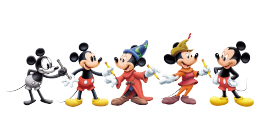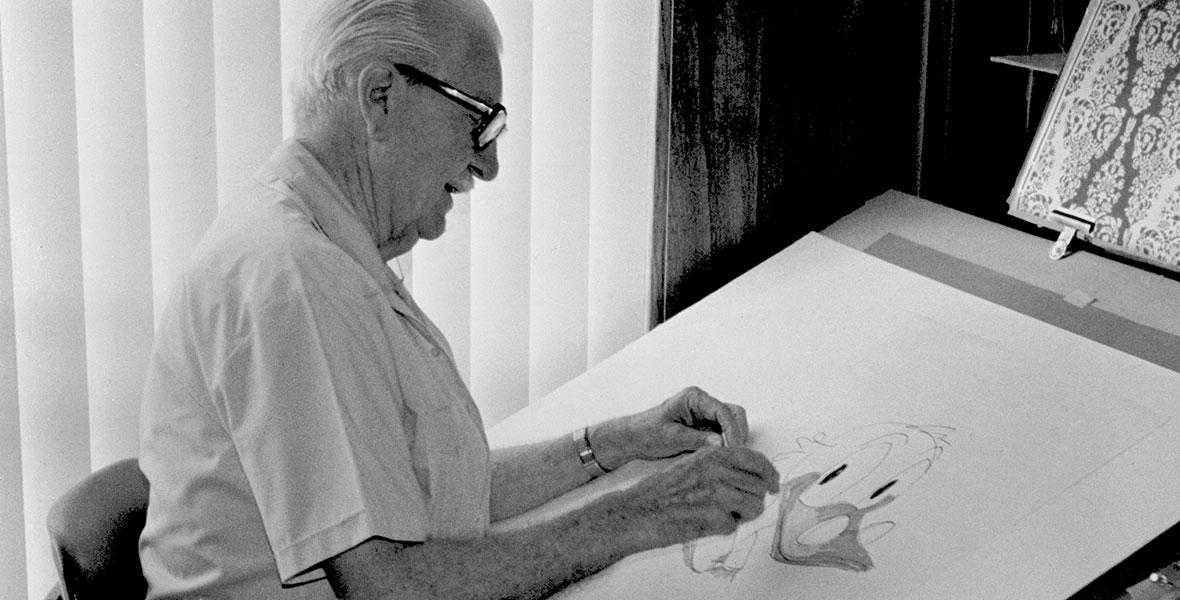As a cartoonist, Carl Barks was no quack—although his characters were. Called “The Duck Man” by many, Carl’s name is synonymous with Disney ducks; he dedicated his comic book career to these feathered heroes, retelling the countless exploits of Donald Duck, his nephews Huey, Dewey, and Louie, and Uncle Scrooge McDuck.
Ironically, when Carl joined the Walt Disney Studio in 1935 and met Donald Duck for the first time, his initial impression of the cantankerous character was that he was “an unintelligible troublemaker that would find very few roles suitable for his temperament.” In time, however, Carl said he gained an affinity for Donald and never again judged the Duck by his ruffled feathers.
Born March 27, 1901, and raised on an Oregon farm, Carl worked a variety of jobs, ranging from logger to factory worker, before he became a freelance artist in the 1920s.
A self-taught cartoonist—influenced by the Mickey Mouse newspaper strip—Carl caught wind that the Walt Disney Studio was hiring artists and beat tracks to Hollywood. He joined the animation department in 1935.
Within a few months, Carl moved to the story department where he helped write stories for cartoons, including the Donald Duck shorts Modern Inventions and Timber. In all, Carl collaborated on three dozen Donald Duck cartoons and even helped create Huey, Dewey, and Louie for the 1938 short Donald’s Nephews.
In 1942, he began developing comic books, starting with Donald Duck Finds Pirate Gold, and continued creating comic books until his retirement in 1966. Probably his most memorable creation over the years is Donald’s wealthy uncle, Scrooge McDuck, who debuted in the 1947 story Christmas on Bear Mountain. In 1952, Uncle Scrooge was given his own comic book series, which became a top-seller in the market. Other famous characters of Carl’s creation include Gladstone Gander and Gyro Gearloose, as well as McDuck adversaries the Beagle Boys, Flintheart Glomgold, and Magica De Spell.
After more than 25 years chronicling the adventures of Donald and his family, Carl retired from full-time comic book work. He continued to work with the Disney Ducks in a new medium—oil painting. Through 122 paintings and a series of lithographs, Carl brought his “Duckburg U.S.A.” clan into the world of fine art.
Still, it’s Carl’s comic book work for which he is most famous. Towards the end of his career, the public began to take note of comics as an art form, paying greater heed to the writers and artists whose works were originally published anonymously. Once known to fans only as “The Good Duck Artist”, Carl’s name quickly became famous. He was one of the first inductees into the Eisner Awards Hall of Fame in 1987.
Carl’s canon of comics continue to live on in one of the most popular animated television series of all time, DuckTales, while his comic books have become highly collectible. On October 22, 1991, when honored at the Disney Legends Awards, the 92-year-old artist won a laugh from the audience when he said, “I want to thank all the kids that bought my comic books for a dime and are now selling them for $2,000.”
Carl Barks passed away on August 25, 2000, at age 99, in Grants Pass, Oregon.



